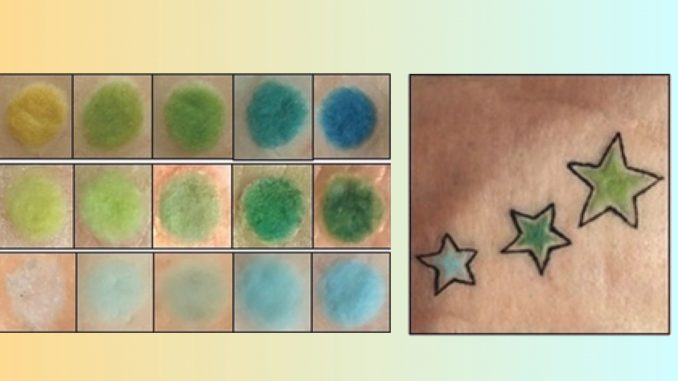
For the most part, tattoos are cosmetic—symbolic at best. Scientists in Germany, however, have created body art that could make more use out of the real estate on your skin than a design with the word “Mom”.
The team, led by chemical engineer Ali Yetisen of the Technical University of Munich, proposes color-changing intradermal tattoos that visually adapt to changing levels of pH, glucose, and albumin in the blood, allowing patients to keep track of their health in real-time without depending on clunky monitors or making the trip down to the doctor’s.
The functional tattoos, freshly inked into the minds of users on the r/BeAmazed community, were first presented in 2019 in the German Chemical Society’s .
The researchers said the idea embraces a custom dating back to thousands of years involving the injection of pigments into one’s dermis layer, and marries tattoo artistry with function to reflect crucial variations in pH, glucose, and albumin concentrations.
At the time of the study, the semi-invasive had only been tested on pig skin, which also happens to be a medium that tattoo artists frequently practice on.
The team chose the three biomarkers because they are often tell-tale signs of extreme body changes. An imbalance in the body’s pH, for instance, could point to an inability in the kidneys and lungs in controlling the acidity of the body. Unusual albumin levels could indicate issues with the kidney, liver, or heart. Finally, glucose levels will, of course, need to be watched closely by diabetics.
This is pretty impressive!
Dermal Tattoo Biosensors for Colorimetric Metabolite Detectionhttps://t.co/q5NZLVtLfW pic.twitter.com/Ye2V1Vz2qw
— JB Manent (@JbManent) July 23, 2019
For the albumin marker, the scientists used a yellow pigment that became greener the higher the concentration. To detect changes in glucose levels, they used a tattoo that turned from yellow to dark green. Meanwhile, the pH sensor relied on methyl red, bromothymol blue, and phenolphthalein.
The team was able to evaluate concentration levels suggested by each tattoo by looking at smartphone photos of the art, a feature that would save considerable time between patients and doctors. In time, the scientists may even produce a calibration chart to assess the gradients when projected under various light conditions.
However, they noted then that only one sensor—the pH tattoo—was reversible, though it might be possible to make the others reversible with synthetic receptors.
Still, these tattoos spell a future where people can track body changes in real-time just by looking at, say, their bicep. Not only that, patients might even make readings their own; as depicted in the pictures, the biosensors can conform to all sorts of shapes and patterns, just like regular body art. It’ll certainly alleviate some of the frustration from having to monitor glucose levels on a daily basis.
The team believes that, moving forward, tattoos may even be designed to observe the body’s hydration level, electrolytes, gases, and so on.
[via
http://www.designtaxi.com/news/420340/These-Cool-Tattoos-Change-Color-When-Your-Blood-Sugar-Level-Shifts/

Leave a Reply